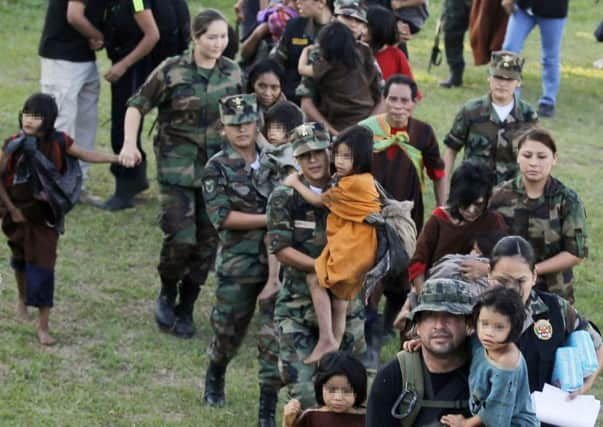Peruvian army rescues dozens of guerrilla captives


Anti-terrorism police chief Gen Jose Baella said some of the adults were kidnapped between 20 and 30 years ago from Puerto Ocopa and nearby towns.
Baella said the children, who were aged between four to 14, and were malnourished and had skin diseases, were being treated by authorities following the rescue operation.
Advertisement
Hide AdAdvertisement
Hide AdAccording to Peruvian deputy defence minister Ivan Vega, the mission took place without shots being fired.
Baella said the women were used to produce child soldiers for the guerrillas and grow crops for them. The oldest of the 34 children was 14, he said Saturday.
Independent security expert Pedro Yaranga said the rescue was not a serious blow to the drug-trafficking Shining Path remnant that operates in the area, but does show how weak it has become.
“These children and the captive mass had been abandoned and were on their own, very far from the place where the columns and the camps of the rebels and their children are located,” he said.
The group was rescued by a special forces unit comprised of soldiers and police in helicopters on Friday and Monday, said Baella. Members of the group have been reunited with relatives they had not seen for decades, he added.
Baella said none were being immediately presented to the media. They were receiving medical treatment and being interviewed by prosecutors at the counternarcotics police base in Mazamari.
The rescued group was living in a various camps in thick jungle with a 50-metre canopy in a place called Sector V in the Satipo province of Junin state, officials said.
Two Shining Path deserters, who were raised in the camps, had led authorities to them, and a total of 70 people have been rescued from such camps in the past year, said Baella.
Advertisement
Hide AdAdvertisement
Hide AdAnalysts estimate that Shining Path’s strength to be no more than 200 fighters.
It has been seriously weakened in recent years with the capture of top commander “Artemio” in 2012, and the killings of two top cadres the following year in an ambush by security forces. Its last refuge borders Peru’s main cocaine-producing region, the Apurimac, Ene and Mantaro river valley.
Shining Path, a Maoist group, launched armed operations against the state in 1980. Throughout that decade it grew, both in terms of the territory it controlled, and in numbers in its organisation, particularly in the Andean highlands.
About 70,000 people were killed between 1980 and 2000 as the government battled Shining Path and a rival leftist armed group, the Tupac Amaru movement, according to Peru’s independent Truth and Reconciliation Commission.
Last year, the group’s two top leaders – brothers Victor and Jorge Quispe Palomino – were indicted in the United States on charges including conspiracy to commit narco-terrorism.
Fctions of Shining Path now claim to fight in order to force the government to reach a peace treaty with the rebels.
On Monday, Vega announced that 26 children and 13 women had been rescued in a separate operation, bringing the week’s total of rescued captives to 54.
The women are raped under rebel captivity to produce the Maoist group’s future guerillas, Vega told Canal N television earlier this week.
Advertisement
Hide AdAdvertisement
Hide Ad“The women are made pregnant so that their babies will fill Shining Path’s ranks,” Vega said.
“The children are trained to care for coca growing until they are 12 to 14, which is when they go into Shining Path active duty,” Vega said.
Shining Path rebels occupy areas of Peru’s untouched jungle in the VRAEM region, known as the country’s cocaine production hub.